Neurodiversity information for parents and young people
This guide will help you to:
- prepare before you come to hospital for your surgery
- prevent chest or circulatory (heart and blood) problems
- move more easily
- be more comfortable after surgery
- exercise your pelvic floor and abdominal (tummy) muscles to help prevent bladder and bowel problems and back pain
- regain your previous fitness levels.
Before surgery: preparing for surgery before you come to hospital
Improving your fitness before you have surgery has been shown to result in a quicker recovery. It can help you avoid post-operative complications.
- If you can, try to increase the amount of exercise that you take.
- Exercise can be broken down into 10 minute sessions which you can spread across the week. Or you can exercise for 30 minutes on 5 days of the week.
- Do whatever suits your lifestyle and current levels of fitness.
To prepare for surgery, practise deep breathing and circulatory exercises
Immediately after you have your surgery in hospital, it will be important that you take some deep breaths. Taking these deep breaths will help in the following ways:
- It will reduce your risk of getting a chest infection or other lung complications.
- It will help to maintain good circulation (blood flow in your veins) and prevent the formation of blood clots.
Use the drop-down menu for information on breathing and circulation exercises.

Practise these exercises now. If you practise them now, you will be familiar with the exercises when you come to hospital for your surgery.
Deep breathing
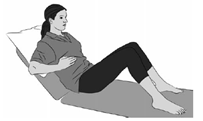
- Sit comfortably, as upright as you can.
- Place your hands on the sides of your ribcage if you can.
- Take a deep breath in and feel your rib cage expand under your hands.
- Hold your breath for 2 to 4 seconds if you can.
- Slowly breathe out.
- Repeat this 3 times.
Practise this breathing exercise frequently throughout the day. You can do it when you wake up, after breakfast, at mid morning, after lunch, at mid afternoon and before you go to bed.
Ankle pumps (to boost circulation)
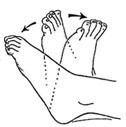
- Sit or lie down.
- Bend your feet and ankles up and down quickly for 1 minute.
Practise this exercise whenever you are sitting down or when you are lying in bed before you fall asleep.
Immediately after surgery while you are in hospital: help your lungs to recover
It is important to take deep breaths immediately after surgery. You also need to cough up any phlegm (or mucus) in your lungs. This will help to prevent chest infections such as pneumonia.
Use the pull-down menu for exercises to do as soon as you can after your surgery. Keep doing them until you feel you are as mobile as you were before you had surgery.

Pain can slow down your recovery. If it is painful to take deep breaths or cough, tell your nurse, doctor or physiotherapist so they can adjust your pain medication.
Deep breathing
Immediately after your operation, do this exercise every half hour. Keep doing it until you can take several short walks a day on the ward.
- Sit comfortably in an upright position.
- Place your hands on the sides of your ribcage if you can.
- Take a deep breath in and feel your rib cage expand under your hands.
- Hold your breath for 2 to 4 seconds if you can.
- Slowly breathe out.
- Repeat this 3 times.

Coughing
- Do not worry about harming your stitches or scar when coughing.
- It may feel more comfortable to hold a pillow or a folded towel firmly over your stomach when coughing.
- It is important to let the nurses, doctors or physiotherapists know if it is too painful to cough. They will be able to adjust your pain medication.

During your stay in hospital: getting moving
Use the drop-down menu for guidance on getting moving more easily after surgery.
Getting out of bed
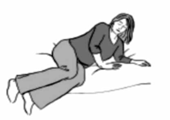
Getting out of bed will be easiest if you roll onto your side first.
- Bend your knees up and roll onto your side.
- Let your legs slide off the bed first.
- Push yourself up into a sitting position with your hands and forearm.
- Sit for a minute.
- When you are ready to stand, push up with your hands and your legs.
- Try to keep your back straight.
Walking
- If you feel well enough, try to walk on the day after your surgery. If you cannot walk on the first day, try to walk on the second day after your surgery.
- Nurses or physiotherapists will help you to manage any drips or drains until you can walk safely by yourself.
- When you can walk safely by yourself, you will need to walk regularly throughout the day. Try to increase the distance that you walk every day.
Going to the toilet
It is natural to feel a little worried the first time you go to the toilet after your surgery.
The picture below shows you how to sit to make yourself more comfortable and help you relax.
After your operation, you may have a catheter (a small flexible tube) to drain your bladder for a few days.

Once your catheter is removed and you first attempt to wee, tell your nurse immediately if you do not experience the sensation of needing to wee, or if you have difficulty emptying your bladder.
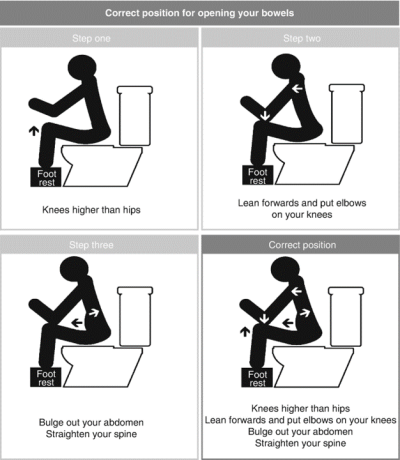
After surgery: exercise your pelvic floor and abdominal muscles
It is important that you exercise your pelvic floor and abdominal (tummy) muscles following your surgery.
Use the drop-down menu for information on pelvic floor and abdominal muscle exercises.
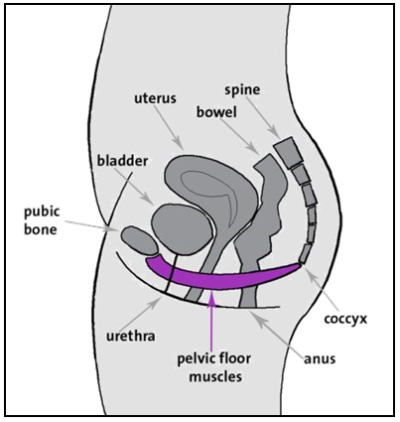
Pelvic floor exercises
The pelvic floor consists of layers of muscle and ligament (connective tissue) that stretch like a hammock. They stretch from your pubic bone to your coccyx (tailbone) and from side to side.
Pelvic floor muscles do the following:
- help to hold your bladder, womb and bowel in place
- help to control your bladder and bowel function
- help with sexual enjoyment.
It is important that you get these muscles working again after your surgery for the following reasons:
- to reduce discomfort and swelling
- to prevent leakage from your bladder or bowel
- to help prevent problems in the future, such as prolapse (slippage) of pelvic organs.

If you have a catheter, wait until it is removed and you have passed urine on you own before doing the following pelvic floor exercises.
How to do pelvic floor exercises
Like all the muscles in your body, the more you exercise your pelvic floor muscles, the stronger they will become.
You can do these exercises even if you have stitches from vaginal surgery. You may need to start more gently.
- Start by lying on your side or back, or sitting in a chair.
- Imagine that you are trying to stop yourself passing wind and passing urine.
- You will feel your muscles “squeeze and lift” from your back passage (anus) all the way to the front.
Make sure you do slow and fast pelvic floor exercises.
Slow
- Squeeze and lift your pelvic floor muscles.
- Hold the squeeze for as long as you can (up to 10 seconds). Holding for 10 seconds may be difficult for you at first, but it will get easier with regular practice.
- Release and rest for 5 seconds.
- Repeat this exercise 10 times.
- To progress your exercises further, try doing them in a standing position.
Fast (helps train your muscles to react quickly when you laugh, cough, sneeze, exercise or lift).
- Tighten your pelvic floor muscles as firmly as you can and release.
- Aim to repeat this 10 times.
- To progress your exercises further, try doing them in a standing position.
You may find it helpful to build these exercises into your regular daily routine.
You can do them every time your brush you teeth, when you put the kettle on, or during a television advert break.
Try to practice these exercises at least 3 times every day. Do this for the rest of your life!
Abdominal (tummy) exercises
It is important to strengthen your abdominal muscles because they help to stabilise your back. This is especially true if you have incisions (surgical cuts) on your tummy. These exercises may may also help to relieve backache and trapped wind.
Start the following exercises as soon as you feel strong enough.
Abdominal hollowing
- Lie down with your knees slightly bent.
- Place your hands on your lower abdomen.
- Breathe in through your nose.
- As you breathe out, pull you abdomen away from your hands and towards your spine.
- Hold for a few seconds, and then relax.
- Repeat up to 5 times.
- Do this up to 3 times a day.
Pelvic tilts
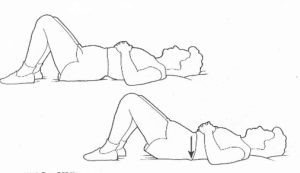
- Lie down with your knees slightly bent.
- Pull the muscles of your abdomen in and flatten your back against the bed.
- You will probably feel your pubic bone tilting upwards.
- Hold this position for a few seconds, then release gently.
- Repeat up to 5 times.
- Do this up to 3 times a day.
Knee rolls
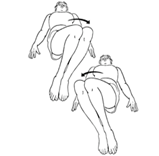
- Lie down with your knees slightly bent.
- Draw in your lower abdomen.
- Keep your shoulders flat on the bed or the ground.
- Gently lower both knees to one side (as far as you can so that it is not too painful or uncomfortable).
- Bring your knees back to the middle then lower them down to the other side.
- Repeat this exercise up to 5 times.
- Do this up to 3 times a day.
Recovery after surgery
Recovery after surgery varies from person to person, but everyone returns to normal activity gradually.
It is essential to make sure you get enough rest following surgery. Some women are more vulnerable after surgery, including women who:
- are over 60 years old
- have had surgery before
- are overweight
- have weak pelvic floor muscles.
If you are in any of these categories, we advise you to take more care with your recovery.
When you are back home: returning to everyday activities
Use the drop-down menu for guidance to help you resume everyday activities after surgery:
- Car journeys
- Driving
- Work around the house
- Lifting
- Sexual activity
- Sport and exercise.
Car journeys
If you are travelling in a car after your surgery, you may find it more comfortable if you place a folded towel between the seatbelt and your tummy.
Driving
Getting back to driving will depend on the type of operation you have had. If you have had major surgery it is advisable to wait 3 to 6 weeks.
Wait until you feel fully fit to drive and always:
- check your car insurance cover
- check you can wear a seatbelt comfortably
- make sure you can concentrate fully on the road
- make sure you are able to perform an emergency stop.
Work around the house
- Avoid heavy work around the house until 6 weeks after surgery. Do not carry full laundry baskets or heavy shopping bags. Do not mow the lawn or vacuum your floors.
- Only carry what you can comfortably manage with one hand, such as a full kettle.
- If you are preparing food, you will be more comfortable if you sit down to prepare it.
Lifting
Avoid heavy lifting until 6 weeks after your surgery. Until then, do not life more than 1 to 2 kg of weight.
Try to get help from friends and family, especially if you need to look after babies or young children.
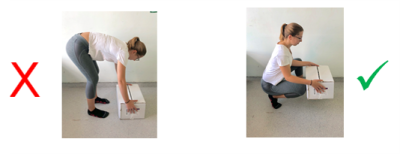
When you start to lift things, do the following;
- bend your knees
- tighten your abdominal muscles
- lift and hold your pelvic floor muscles
- breathe out
- keep your back straight
- hold the object close to your body
- straighten your knees to stand up (let your legs do the work instead of your arms or back).
Sexual activity
- The right time to resume sexual activity varies from person to person. It will depend on the type of surgery you have had.
- You might prefer to wait at least 3 to 6 weeks before resuming sexual intercourse. Be guided by how ready and comfortable you feel.
- Make sure that any bleeding has stopped.
- Some women may prefer to wait until they have a post-surgery follow up appointment.
Sport and exercise
Walking and the exercises listed above are recommended for the first 6 weeks after your surgery.
- Aim to walk each day.
- Start with 5 to 10 minutes of walking.
- Gradually increase the time, pace and distance.
- Remember that walking downhill will put more strain on your muscles.
After 6 weeks, you can return to light low impact exercise. This includes pilates, cycling and brisk walking. If you are exercising with an instructor, it is important that you tell them you have had gynaecological surgery.
After 6 weeks, you may also be able to start swimming. You can do this only if your wound is dry and healed, and any vaginal discharge and bleeding has stopped.

Avoid more physically active sports and high impact exercise until at least 12 weeks after surgery.
Important information
It is important to monitor your pelvic floor as you increase the intensity of your exercises.
Scale back your exercises and speak to your GP if you experience any of the following:
- Any leaking from your bladder or your bowel
- A bulge or heaviness in your vagina.
Your GP may refer you to a specialist healthcare professional.
Return to work
Your return to work will depend on the type of work that you do and the surgery you have had.
If you have a desk based job, you may be able to return within 3 to 6 weeks.
If your job involves heavy lifting or standing still for long periods, you may need to wait longer before you return to work.
![]()
Speak with the hospital doctors or your GP to arrange a Statement of Fitness for Work (sick note).
Contact information
Kingston Hospital Physiotherapy Department, Monday to Friday 8am to 5pm